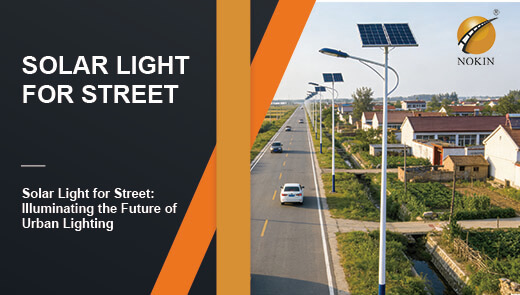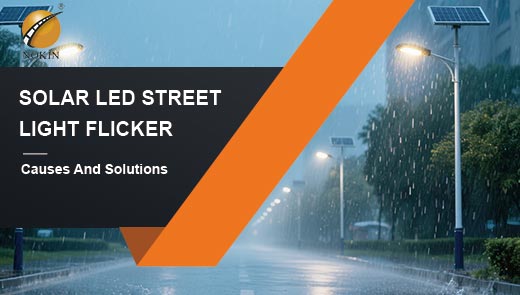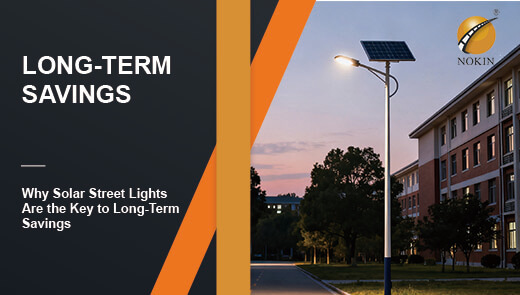How to Turn Solar Street Lights On and Off Automatically?
Under the backdrop of global low-carbon transformation, solar street lights have been widely applied in outdoor scenarios such as urban roads, community courtyards, parking lots, and scenic area walkways, thanks to their advantages of "zero electricity charges, easy installation, and no pollution". Unlike traditional municipal street lights that require manual or fixed circuit control, the "automatic on/off" function of solar street lights is their core highlight - they can start and stop autonomously according to environmental changes, which not only saves labor costs but also maximizes energy-saving effects.
But many users have doubts: Why can solar street lights light up automatically at night? Besides "turn on the lights when it gets dark and turn them off when it gets light", what other automatic control methods are there? How can we ensure the stable operation of the automatic function in daily use? Next, NOKIN will comprehensively answer the key questions about the automatic switching of solar street lights from principles, methods, precautions to common problems, providing users with practical guidelines.
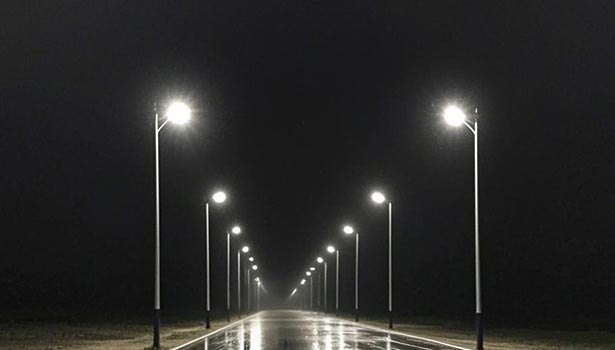
Principle of Solar Street Lights Automatically Activating at Night
The automatic on/off function of solar street lights is not a "single function", but is achieved through the collaborative efforts of different components. Among them, the light-controlled components are the foundation, while time control and human body sensing are advanced supplements. Together, they form the automatic control system.
Light-controlled Switch
The light control switch is the most fundamental automatic control device of solar street lights. Its core logic is "sensing the ambient light intensity and triggering the switch to act." It is equipped with a sensitive-adjustable light-sensing module that presets two key thresholds: "On light threshold" and "off light threshold". When the light gradually dims in the evening and the light intensity drops below the "lighting threshold", the light control switch will automatically connect the circuit, allowing the electrical energy stored in the battery to be delivered to the light beads to achieve lighting. When the morning light intensifies and exceeds the "lights-off threshold", the switch disconnects the circuit, the street lights go out, and at the same time, the solar panels start to absorb sunlight for charging.
This method is fully in line with the changes of natural light and does not require manual intervention. It is a "standard" function of the vast majority of civilian solar street lights.
Photoresistor
A photoresistor has a similar function to a light control switch, but its working method is slightly different - it does not directly control the circuit, but instead transmits signals to the street light controller through the characteristic that "the resistance value varies with the light intensity".
When there is sufficient light, the resistance value of the photoresistor is extremely low. After the controller receives the "low resistance signal", it determines that it is "daytime". At this time, the solar street light remains off and charges first. When the light dims, the resistance value of the photoresistor will suddenly rise to several thousand or even tens of thousands of ohms. After receiving the "high resistance signal", the controller immediately switches to "night mode" and starts the street lighting.
Compared with ordinary light-controlled switches, photoresistors have higher sensitivity and can more accurately capture subtle changes in light intensity, making them suitable for scenarios with high requirements for light perception.
Auxiliary Automatic Component
In addition to light-controlled components, some solar LED street lights are also equipped with two advanced automatic functions to further enhance flexibility:
Time control switch
The core of the time control switch is to "execute instructions at fixed times". Users can preset specific on/off times through the street light controller or the accompanying APP, such as "turn on the lights at 18:30 and turn them off at 5:30 the next day". After the Settings are completed, the time controller will automatically connect or disconnect the circuit at the preset time points.
This approach is suitable for scenarios where "lighting changes irregularly but fixed lighting periods are required", such as temporary roads under night construction or courtyards in residential areas.
Human body sensing sensor
The human body sensing sensor is an "energy-saving upgraded version" function, which can detect human activities within a range of 5 to 10 meters around. When no one passes by, the street lights remain at low brightness or are completely turned off. When people or vehicles approach, the sensor is immediately triggered and the street light switches to high-brightness lighting. It will automatically return to low brightness or turn off 30 to 60 seconds after people and vehicles leave.
This method can significantly reduce energy consumption and extend battery life, making it particularly suitable for scenarios with less foot traffic such as suburban roads, scenic area trails, and corners of parking lots.
3 Ways to Turn Solar Street Lights On and Off Automatically
Optical Sensor Control
Light sensor control is the "most worry-free" method, which operates automatically relying entirely on the ambient light intensity without the need for manual Settings.
When solar street lights leave the factory, the manufacturer will set the light intensity threshold by default (such as 50lux when the light is on and 200lux when it is off), and users do not need to perform any additional operations. During the day, solar panels absorb sunlight and store electrical energy in lithium batteries. In the evening, when the light intensity drops, the sensor triggers the lights to turn on. In the early morning, as the light intensity rises, the sensor triggers the lights to turn off. The entire process is fully automatic.
Core advantage
- Zero human intervention: No need for daily adjustment, suitable for unmanned scenarios (such as remote rural roads);
- Maximize energy conservation: Only turn on the lights when there is insufficient light to avoid waste such as "accidental lighting during the day" or "early turning off at night".
- High safety: It can handle sudden weather conditions (such as turning on the lights in advance on cloudy or rainy days) to ensure road traffic safety.
Applicable scenarios
Scenarios such as ordinary urban roads, main roads in residential areas, lakeside walkways in parks, and areas around school playgrounds where lighting needs to be adjusted according to natural light.
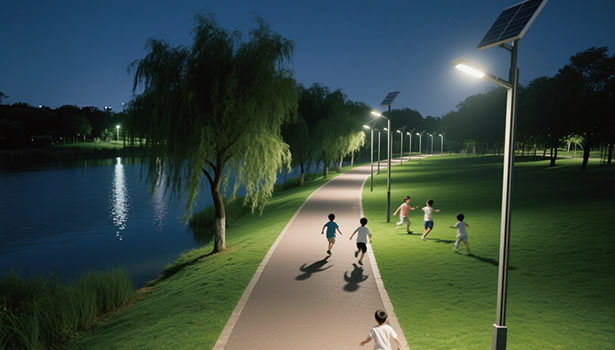
Time Controller
The time controller is suitable for scenarios where "the lighting period is fixed and not affected by light intensity", with the core being "execution according to the preset time and precise controllability". Users need to first set the specific "on time" and "off time" through the controller panel of the street light or the accompanying APP. For example:
In summer, set the lights to "turn on at 19:00 and turn off at 5:00 the next day".
In winter, set the lights to "turn on at 17:30 and off at 6:00 the next day".
For temporary scenarios (such as night construction), set the lights to "turn on at 20:00 and off at 24:00".
After the Settings are completed, the time controller will automatically switch the circuit state at the preset time point through the built-in clock module. Even on cloudy or rainy days, it will still execute according to the time (if temporary adjustments are needed, the time can be manually modified).
The advantages of time controllers
- Precise timing: Suitable for scenarios with strict requirements for lighting periods;
- Flexible adjustment: The time can be modified at any time according to the season and usage requirements.
- Strong stability: Not affected by extreme weather conditions (such as abnormal light intensity caused by continuous overcast and rainy weather).
The applicable scenarios of time controllers
Nighttime construction roads, areas around night snack stalls in residential communities, and sections under municipal maintenance, etc.
Wireless Remote Control
Wireless remote control is an "advanced control method". Users can control the on/off of a single or multiple street lights anytime and anywhere through a remote control or a mobile phone APP, achieving "precise and personalized" control. The core of wireless remote control is "radio frequency signal transmission" : when the remote control or APP issues a switch command, the street light controller receives the signal and immediately executes the corresponding action.
The advantages of wireless remote control
- Flexible operation: No need to go to the site; remote control is available.
- Precise grouping: Suitable for centralized management of multiple sections and scenarios;
- Fast emergency response: In case of emergencies, the lights can be turned off remotely immediately.
The applicable scenarios of wireless remote control
The scenic area features multi-zone lighting, commercial streets, industrial parks, etc.
4 Precautions for the Automatic Control of Solar street Lights
To ensure the long-term stability of the automatic switch function of solar powered street lights, four key points should be noted during daily use, covering inspection, weather response, equipment operation and maintenance.
Regular System Inspection
The automatic control of solar street lights relies on the coordination of "panel - battery - controller". Any failure of any component will lead to the failure of the automatic function. Therefore, a basic check needs to be conducted once a week or once a month.
|
Inspection Area |
Inspection Content |
Possible Problems and Impacts |
|
Solar Panel |
Check for dust, leaves, bird droppings, or other coverings. |
Coverings can reduce charging efficiency, causing insufficient battery power and delayed automatic switching. |
|
Battery |
Check if the battery wiring is loose. |
Loose wiring can cause poor circuit contact, resulting in the street light flickering on and off. |
|
Controller |
Check whether the indicator lights are functioning normally (“charging light” on indicates charging, “load light” on indicates lighting). |
Abnormal flashing of indicator lights indicates a fault that needs to be investigated. |
Deal with the Impact of Weather
The automatic function of solar street lights is greatly affected by the weather. Manual adjustment is required in the following situations to avoid affecting usage:
- Low-light environment (continuous rainy or hazy days) : The light sensor may cause the light intensity to remain below the threshold for a long time, resulting in the street lights remaining lit continuously and the battery power depleting rapidly. At this point, you need to manually turn off the street lightor switch to the time-controlled mode (set a shorter lighting time) to avoid battery depletion.
- Cold weather (sub-zero temperatures in winter) : Solar panels may freeze, leading to a decrease in charging efficiency; The battery capacity will also be reduced due to low temperatures (for example, at -10 ℃, the capacity may drop to 70% of the normal level). At this point, it is necessary to clear the snow and ice on the panel in advance, or install an insulation cover for the battery. If necessary, manually recharge it.
Remote Control and APP Operation
Wireless remote control and APP are convenient tools, but improper operation can easily lead to equipment failure
- Avoid frequent pressing of buttons: The lifespan of the buttons on a remote control is approximately 10,000 times. Frequent pressing accelerates the aging of the buttons, leading to signal failure.
- Maintain operating distance: The effective range of a remote control is usually 10 to 30 meters. Forcing operation beyond this range may result in signal loss. It is necessary to approach a street lightbefore controlling.
- Stable APP connection: When using the mobile APP for control, it is necessary to ensure a stable Bluetooth/WiFi connection between the mobile phone and the street lightcontroller to avoid repeatedly sending instructions when the connection is interrupted.
Installation and Maintenance
Whether the installation is standardized directly affects the stability of the automatic function. When installing, please pay attention to:
- Site selection: Solar panels should face south (in the Northern Hemisphere) and avoid being blocked by trees or buildings (blocking can lead to insufficient charging and delayed automatic switching).
- Tools and Steps: Use tools such as screwdrivers and electric drills to fix the panel and lightbody. Connect the circuits as per the instructions (do not reverse the positive and negative poles, otherwise the controller will be burned out).
- Testing: After installation is completed, use the remote control to test the automatic functions (such as blocking the panel to simulate darkness and check if the lights turn on automatically; removing the obstruction to simulate dawn and check if the lights turn off automatically). Only after confirming that everything is normal can it be put into use.
During daily maintenance, the solar panels need to be cleaned once every quarter (wipe with clean water or a damp cloth, avoid scratching with hard objects), and the LED beads should be inspected once a year (aging of the LED beads will cause a decrease in brightness, and they need to be replaced in time).
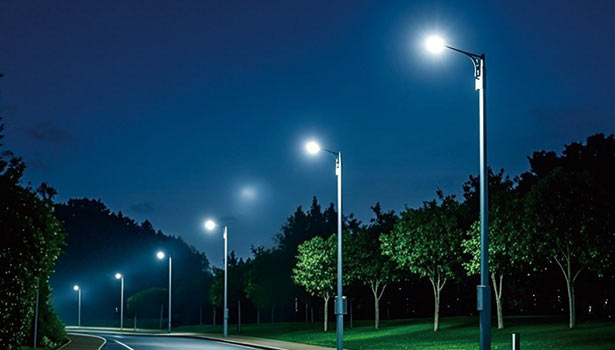
FAQs about Automatic Control of Solar Street Lights
Can remote-controlled solar street lights be used in rainy days?
Most solar street lights have a protection level of IP65 (dust-proof and water-proof), and can be used normally in rainy days. However, it should be noted that
- Avoid prolonged immersion: If rainwater submerges the bottom of the lightbody (such as on waterlogged sections), it should be moved to a higher position promptly to prevent internal water ingress and short circuit.
- Post-rain inspection: After the rain, check the controller for any signs of water ingress (such as abnormal indicator lights). If so, power off and let it dry before using it again.
What causes the street lights to flicker frequently and the automatic switch to be unstable?
There are mainly two reasons:
- Low battery power: When the battery power is insufficient, the output voltage is unstable, causing the street lightto flicker. It needs to be charged in time.
- LED chip failure: Some LED chips may age or burn out, causing abnormal circuit current. The LED chip board needs to be replaced (it is recommended to contact the manufacturer's after-sales service).
What should I do if the solar street light brightness fluctuates and the automatic adjustment is irregular?
It might be a problem with the light sensor or controller
- Contamination of the light sensor: Dust or oil stains on the sensor surface can lead to inaccurate light intensity detection. Wipe the sensor surface with a damp cloth.
- Controller parameter disorder: The light intensity threshold of the controller has been mistakenly modified. It is necessary to restore the factory Settings according to the manual and recalibrate the threshold.
How to choose the right automatic control solar street light for yourself?
|
Selection Dimension |
Suggested Scheme |
Description |
|
Scene Requirements |
For ordinary roads, select the combination of “light control + time control.” For low foot traffic areas, choose “light control + motion sensor.” For multi-area management, select “wireless remote control.” |
Choose the control mode according to the usage scenario to improve lighting efficiency and energy savings. |
|
Brightness Requirements |
For main roads, select 100W or above (brightness ≥10,000 lux). For courtyards, choose 30–50W (brightness ≥3,000 lux). |
Different scenarios require suitable power and brightness levels to ensure optimal lighting performance. |
|
After-sales Requirements |
Prioritize manufacturers that provide a “3-year warranty (1-year battery warranty).” |
Manufacturers offering longer warranties can ensure more reliable maintenance and long-term product stability. |
In the future, with the development of Internet of Things technology, the automatic control of solar street lights will become more intelligent - for instance, by using AI algorithms to predict the weather and adjust the lighting time in advance. Or it can be linked with the urban traffic system to automatically adjust the brightness according to the traffic volume. However, no matter how technology upgrades, "regular maintenance and correct operation" remain the core for ensuring the stability of automatic functions.

